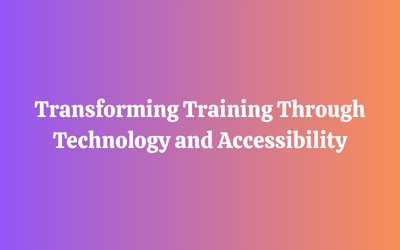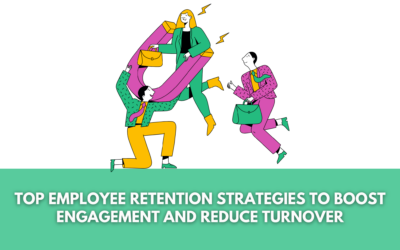Find and fill skill & knowledge gaps in your organization
Several organizations are observing skill & knowledge gaps as they quickly adopt new models and tactics to take advantage of updated technologies and satisfy shifting client expectations. These gaps are widening as more workers are being asked to perform tasks for which they were neither hired nor educated.
Three out of ten poll respondents added that 25% of the jobs in their companies were in jeopardy as a result of shifting market trends. Just one-third of the participants, however, acknowledged that their companies were ready to deal with the workplace disruptions that such rapid change can bring about.
This information emphasizes the need to close knowledge and skill gaps and the fact that few companies are equipped to do so. It is essential to close these gaps because they could be your company’s largest vulnerability. This article explains how your organization may spot these holes and close them before they harm your operations.
What Are Workplace Knowledge and Skill Gaps Mean?
Knowledge and skill gaps typically refer to shortcomings in your employees’ work performance. It is the discrepancy between a worker’s current skill set and the abilities required for effective job performance. These gaps are a result of either hiring inexperienced workers or workers that are unqualified for the position.
Because of a labor shortage, businesses are frequently obliged to hire workers who do not have the requirements. Due to ambivalence on the part of the employees and inadequate training, these gaps are further compounded. These shortfalls frequently result from the market’s shifting dynamics, which force businesses to continuously reinvent themselves and reskill their workforces.
To increase its revenue and sales, a company must find these holes right away and fill them. A worker who lacks the necessary expertise could cost the company a potential client or customer. These workers decrease overall workplace productivity, make it challenging to meet objectives, and direct customers to your competitors. Employees may become demotivated and ultimately quit if they are unable to perform their work effectively.
Human Resources employees and hiring managers cite advanced data analysis, critical thinking, attention to detail, communication skills, and management of people as some of the important competencies that have been lacking in their most recent hires.
Because every workplace is unique, you must identify the precise knowledge and skill gaps in your staff if you want to flourish.
4 Reasons for Workforce Skill Gaps
When it comes to lost productivity, high turnover, morale, team innovation, revenues, and other factors, a skills gap is expensive for businesses. To determine the essential skills gap and precisely what it would take to close the gap with training programs, it is crucial to quickly analyze the situation.
1. New technologies
Digital skill gaps are being produced by technological progress at a quick rate which makes them difficult to close. Several jobs have been rendered obsolete by automation and artificial intelligence, but new ones have been developed to support these technologies. The gig economy also alters how employees deliver those specific abilities and how hiring managers look for applicants.
2. Insufficient education
Lackluster education results in skill gaps. To help close crucial skill gaps, it has to evolve at all levels. Given the growing demand for digital capabilities across all industries, many employees lack the necessary skills. It’s critical to incorporate additional technology into core skilling whenever it’s feasible.
3. Job-based training
Lack of on-the-job training is another factor in skill gaps since employers no longer hire and develop employees based on potential. Instead of taking the time to make their own, they would rather go shopping for a cheese-ready sandwich. Employing managers look for “expert” personnel due to the emphasis on quick results. An opportunity to invest in long-term workers and outcomes is being missed.
4. The absence of soft skills
Soft talents enable people to enjoy working with other teammates. It’s like cooking bacon; either you get it right or you burn it. Like delicious bacon, soft talents make work life manageable and include skills like:
- Creativity in problem-solving, resolving conflicts, and other areas help businesses compete.
- Leadership and client interactions both require the ability to persuade.
- Collaboration improves results and is a necessary skill for a company to run smoothly.
- A corporation can stay afloat and overcome difficult obstacles by being adaptable.
- Emotional intelligence, a soft skill that strengthens working connections, is a component of effective communication.
Facing Challenges When Closing the Skills Gap
The number and quality of employees who are available to meet the needs of the contemporary labor market are inequitably distributed. However, resolving these issues can be difficult for both employers and employees.
Building the infrastructure required to find, hire, train, and upskill their personnel may prove tough for employers. Many businesses place more emphasis on identifying candidates who can satisfy an immediate need than on finding people they can develop throughout a career. When you couple this with a workplace that is changing swiftly, you will soon see more skill gaps.
The idea of training or retraining can be intimidating for some people. It requires choosing the best path forward and investing time and energy in developing new abilities.
Even though it seems difficult to get over these barriers, there is still hope. The skills gap can be addressed by businesses, industries, and people in several ways.
How to Spot the Knowledge and Skill Gaps at Work?
Here are a few actions you may take to determine the knowledge and skill gaps that are affecting the success of your business.
Establish the goals of your company.
You must first be certain of your organization’s objectives to identify any performance gaps among your staff. It would be helpful to have a clear understanding of the objectives you wish to accomplish going forward, as well as what new jobs require creating and filling.
Determine the prerequisite qualifications.
It would be preferable to determine what skills are necessary to support you in achieving your long-term goals. This is crucial if you intend to rename your company or implement new technologies or methods at work. You must decide what kind of training, skills, and job experience an applicant will require for a certain position in your business.
Analyze the current scenario.
You must evaluate the existing performance of your staff to see if it is sufficient for you to meet the objectives you have set. This will enable you to identify the knowledge gaps in your staff and train and reskill current workers following the demands of your business. It will also assist you in deciding whether you need to hire additional personnel or develop new positions.
5 Steps to Conduct a Skill Gap Analysis
You must first conduct a knowledge gap analysis in your company before conducting a skills gap study. Here are some actions that can assist you in doing that.
1. List the important performance indicators.
Key performance indicators are quantifiable metrics that demonstrate an organization’s effectiveness. These might be qualitative, like customer satisfaction levels, or quantitative, like the amount of money generated or returns on assets. To evaluate the performance of various industries, businesses, and divisions, various sets of KPIs are employed.
Determining the important KPIs for your firm or department is the first step towards efficiently assessing your success. You may see where your business is falling short or missing by monitoring these indications and KPIs.
2. Do an employee evaluation
Together with monitoring your employees’ performance through KPIs, you should also regularly assess and test their knowledge. You can use this to better understand the unique issues that each employee is experiencing and take action to address them.
3. Examine the workplace.
Nevertheless, relying solely on assessments won’t provide you with a clear picture of how well your employees are doing. As a result, you must watch them as they perform their jobs. This could identify problems that weren’t apparent during assessments and give more information about their ability gaps.
4. Request feedback from clients and staff
Employees and customers should regularly provide feedback and reviews because doing so could bring to light problems you might have overlooked in the past. This is crucial since it frequently identifies a deficiency in soft skills like teamwork and communication.
5. Find the best achievers in the benchmark.
Giving top performers in your company recognition gives other employees a point of comparison. You can deduce the skill gaps in your other employees by figuring out what they are doing well. Their performance can also be used as a model for teaching other workers new skills.
You must comprehend the most effective methods for bridging these gaps once you have effectively identified the skill and knowledge gaps in your staff. This might be accomplished via retraining, reskilling, or rehiring. To handle these issues most effectively, it would be helpful if you also understood their underlying causes. Use Stratbeans’ AI-based platform, which can effectively assist you in mapping the skills of your staff, to do this.
Our customized talent maps give you a clear picture of the areas in which your staff and company need to develop. Before now, Stratbeans has created personalized talent maps for every employee of many clients and provided a real-time track of key performance metrics to help them discover role-based skill shortages. Afterward, these gaps were filled using data-driven technologies and customized training materials. By producing interesting content and quick daily assessments, Stratbeans makes it simple for employees to improve and cultivate their abilities.
Conclusion
There are knowledge and skill gaps in every organization and industry. To succeed and increase sales, you must instead recognize and close these gaps. By identifying talent gaps, you gain insight into your company and can reassess your tactics and restructure your team to strengthen any weak areas. Additionally, it can assist you to hire employees who are most fit for the company and enhance recruitment efforts. This will stop the potential losses brought on by inappropriate and underqualified staff.
By filling these skills gaps through training, you may promote customer happiness, employee satisfaction, and worker performance. Insuring client retention and expanding your customer base will help you increase sales. Additionally, it will stop workplace disturbances brought on by emerging trends. Also, it will provide your business a competitive advantage over theirs and stop you from losing business to them. You can fill this hole using Stratbeans. Find out how Stratbeans may assist with upskilling your staff by speaking with us.
Learn More
Our News
- AI
- Animations
- Articulate
- Articulate 360
- Articulate Engage
- Articulate Live
- Articulate Presenter
- Articulate Quizmaker
- Articulate Replay
- Articulate Review
- Articulate Storyline
- Articulate Storyline 3
- Articulate Studio
- bite sized learning
- Characters
- Content Library
- Corporate Communication
- E-Learning
- e-Learning Authoring Tools
- Employee Engagement
- Game-Based Learning
- Gamification
- Gamiflexer
- Go Sales
- Healthcare
- Instructional Design
- Interactivity
- Knowledge Transfer
- L&D Trends
- Learning
- Learning & Development
- Learning Experience platform
- Learning Management System
- LMS
- LXP
- Microlearning
- mLearning
- Mobile Learning
- Nugget Learning
- Online Training
- Peek
- Performance Support
- Preso
- Quiz and Assessment Platform
- Replay 360
- Rise
- SCORM
- Screen Capture
- Software
- Storyline 360
- Studio 360
- Training Management
- Trainings
- Uncategorized




